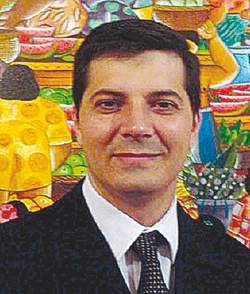http://www.theledger.com/article/20100125/NEWS/1255019/1076/YOURTOWN23?Title=Brazilian-Scientist-Shares-Strategies-to-Fight-Greening
Brazilian Scientist Shares Strategies to Fight Greening
Growers must keep psyllid populations low and remove infected trees to have a chance.
By Kevin Bouffard
THE LEDGER
Published: Monday, January 25, 2010 at 5:49 p.m.
Last Modified: Monday, January 25, 2010 at 5:49 p.m.
LAKE ALFRED | The best strategy for combatting citrus greening, a fatal bacterial disease, remains a vigilant program including frequent pesticide sprays and removing infected trees as quickly as possible.
Florida growers must do both as part of a successful management strategy to hold down greening infection rates in their groves, Renato Bassanezi, a Brazilian epidemiologist, told about 70 academics Monday at the Citrus Research and Education Center in Lake Alfred.
That's based on scientific research and growers' experiences in his country, he said. Brazil is the world's largest orange grower and orange juice manufacturer and has been battling greening since July 2004, more than a year before it was discovered in Florida.
Bassanezi and other scientists refer to the disease as "HLB" for "huanglongbing," its name in China, where the disease first surfaced.
"HLB control is hard and costly, but it is possible," Bassanezi concluded at the end of his one-hour talk. "This HLB-management system is not the ultimate solution, but it is the only one that can succeed (and) can buy time for long-term solutions."
Few would argue with Bassanezi on the necessity of tamping down citrus psyllid populations in the grove. The tiny insects host the greening bacteria and are the main vehicle for spreading the disease.
More controversial, at least in Florida, is his recommendation to remove citrus trees immediately upon the discovery of greening infection. That runs counter to a rival greening management system advocated by Felda citrus grower Murray Boyd, who maintains the disease's spread through a tree can be arrested by chemical and nutritional compounds.
Jim Graham, a soil microbiologist at the Lake Alfred Center, acknowledged the Boyd system is gaining converts in Florida.
"I don't think it will turn out to be a good strategy. I don't think it will work," said Graham, who invited Bassanezi to a weeklong tour of Florida, where the Brazilian scientist will present his findings three more times to local grower groups.
Bassanezi acknowledged Brazil has no experience with the Boyd system, although some growers have expressed interest.
But he questioned the wisdom on delaying tree removal beyond just a couple days because psyllids would acquire the bacteria from the infected trees and quickly spread it to neighboring trees and eventually groves.
"I believe if the infection is still in the tree, it is very dangerous," Bassanezi said.
Bassanezi's presentation included the results from research using various levels of pesticide sprays to control psyllid populations and tree removal to control the amount of bacteria.
Researchers tested those methods in two Sao Paulo groves in high and low infection areas.
Bassanezi also summarized a study based on reports from 80 orange growers in Sao Paulo looking at the relationship between management strategies and infection rates.
He concluded tree removal and aggressive pest control needed to be done on a regional basis. The strategies are less effective, especially in high-infection areas, if only some growers adopt them while neighboring growers do little or nothing to control the disease.
[ Kevin Bouffard can be reached at
kevin.bouffard@theledger.com or at 863-422-6800.
 Renato Bassenezi
Renato Bassenezi 








